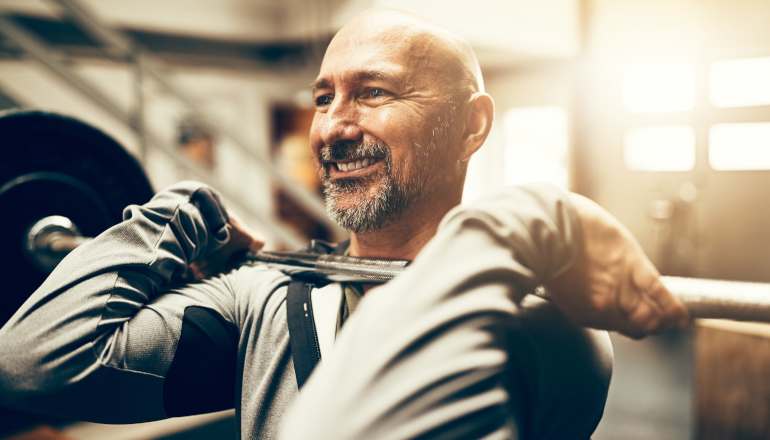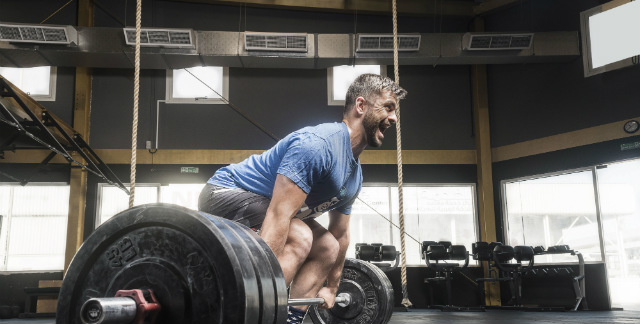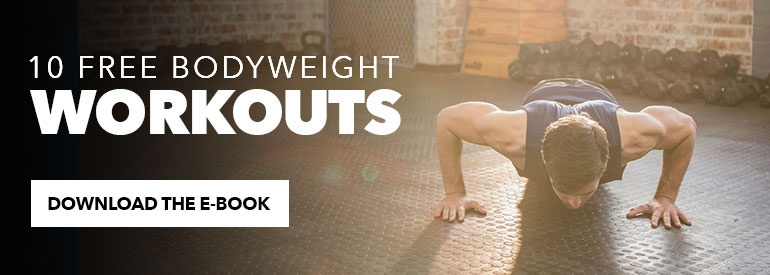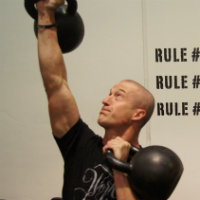 Reading Time: 7 minutes
Reading Time: 7 minutesI recently ran a survey on my Facebook page and was overwhelmed by the response. Hundreds of people over the age of 35 replied and let me know their biggest problems when it comes to getting in shape and staying there.
There were two things that stood out:
- What people saw as their biggest impediments to training. While there were many answers, they boiled down to four main things: previous injury, time, work, and family.
- Out of all the reasons people would seek help with training there were two big ones: decreasing risk of injury or re-injury and getting better results when held accountable to someone.
Perhaps you can see a bit of yourself in those answers from the people in my community? Okay, then — let’s create a workout plan together for anyone, male or female, who is pursuing training success and injury-free longevity.
Here are my recommendations based both on the fact that I myself am over age 40 and I have many clients who are 40-plus, as well.
1. Get Up Early — Every Day
If time and work are issues, and for many of “my people” they are, then you need an all-purpose defense against the inevitable crunch these facts of life will bring. That defense is simple – get up early and train then.
It’s easy to be fooled by most of what the fitness “professionals” post on social media. It may seem like they love getting up early. Here’s the truth: no one likes getting up early to train. Given the choice, every single person would sleep in instead. And double that if you have young kids.

What most fit pros aren’t telling you is that they’re up early for work not their own training. Their clients are up early to train and then hustle off to the office. Meanwhile the personal trainers themselves will slowly wake up over the course of working the morning—and then train around lunchtime. They train at lunchtime because that’s when they have time. You do not have that luxury.
I guarantee very few people will ever schedule a meeting or conference call with you at 6:00am. So, if you go and get your workout done at 6:00am, then it won’t matter when there’s a last-minute meeting or a pile of work dumped on you just as you were planning to leave. It also means that after work you’ll have time for relationship and family duties like playing with your kids or going out for dinner with your partner. Get up and get it done.
Don’t make the mistake most people make, though. Don’t get up early on just the few days a week when you train. Get up early every day. When you know you have to get up early, you’ll go to bed earlier. That means you’ll stop rotting your mind with bad TV shows or mindlessly cruising through social media. Just go to bed and get some extra sleep.
2. Prepare for Injuries After Age 40
Injuries are sadly a fact of life as we get older. If you plan on living an active life, then injuries are going to happen.
And one of the biggest signs of an impending injury is having had a previous injury. As an example, if you’ve had an ACL repair, then you are six times more likely to have another one at some point than if you hadn’t had the first one. Add in calf and Achilles tears for the endurance athletes, shoulder and knee injuries for the power athletes, and the odd neck and back complaint and it’s easy to see why so many of my people give it all up.
But it doesn’t have to be that way. I know plenty of older trainees who have had multiple surgeries and are still out there rocking hard. The key is being smart. Here are some of the strategies I use at my gym to keep the old war horses running smoothly still:
- More focus on mobility. Every time you get hurt you’re going to stiffen up a bit to protect whatever it is you hurt. Those changed motor patterns all need to be addressed to keep you moving as well as possible in the long term. My programs are nearly half mobility and half training. As in, in a sixty-minute session, you will spend about thirty minutes on mobility.
- Remove or reduce lifts like the squat and deadlift. Sure, these moves are fantastic, but sooner or later the cost-to-benefit ratio isn’t going to be so favorable for older backs. These exercises can be replaced with moves like Bulgarian squats or pushing the sled and Romanian deadlifts or kettlebell swings. You’re still going to train the movement and the same muscles, but with far less strain on the body and less risk to the back.
- If you have been injured don’t neglect that area forever. Don’t be the guy who talks about how he blew his knee a decade ago and hasn’t been the same since. There are guys currently playing in the NFL who blew their knees out. You really have zero excuses not to properly rehab and get your injured area functioning properly again given that you won’t be rushed back into a game. Do take your time to get back into it, though. I have clients who have had multiple back surgeries who are deadlifting again and pain free. I have clients who have had knee surgeries who have gone back to competing in BJJ within the year. But we remorselessly target their weaknesses to make sure they never get hurt again.
3. Be Accountable (Even if You Don’t Prefer Personal Training)
As far as being accountable goes I understand private/personal training isn’t for everyone. But these days there are many training options available to us all:
- One-on-one personal training
- Group or semi-private personal training with a small number of people
- Group training
- Online training with someone who provides follow-up calls
- Enlisting the help of a friend so you can keep each other honest
The bottom line is this: I have never seen anyone do better training solo than with someone else. Ever. The training options these days are nearly endless and there is absolutely one that fits your budget and personality. The only real thing stopping someone from finding the right training strategy is a lack of effort.
4. Realism Helps After Age 40
My final tip for is simple — be realistic. There aren’t many workout plans written for those over age 40. The fitness industry doesn’t really care about you. They can’t bamboozle you with fads or sell you thousands of dollars of supplements. Most workouts you’ll find online are written for someone much younger and more foolish than you.
So, when you look at these workouts, just drop some of the work from them. If it says to do five sets, then you do three or four. If it says to do three exercises for a certain movement or body part, as in a bodybuilding-style program, drop one of the exercises.
As much as you’d like to tell yourself you can still hang with the kids, the reality is your recovery ability — the thing that actually dictates whether or not you can make progress — cannot deal with the same stress it could a decade ago.

This being realistic part also applies to diet. No, you don’t need to “eat for size” at age 40-plus. Eating for size generally equals to eating for fatness at our age. After age 40, the body just can’t process higher volumes of food and the rate of muscle growth is lower.
This also means you can’t afford to eat mindlessly (like you used to be able to) and use your activity levels to hide it. Eat more vegetables. Drink more water. Eat slightly less. Your heart and your joints will thank me.
How to Win at Exercise at Age 40 — and Beyond
Don’t give up. You can still kick some butt at 40-plus — as long as you are smart about it and put strategies in place to help you overcome the common obstacles. As with most things, if you apply a bit if self-restraint and some discipline, the results come surprisingly easily, even as a mature trainee.







